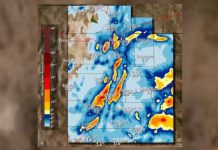Dec. 24 (UPI) — Multiple people have died during a historic winter storm that has knocked out power for more than 1 million homes and businesses and snarled holiday air traffic across the United States.
The death toll from the storm throughout the United States rose to 17 after four people died Friday in auto-related accidents in Kansas and Nebraska, NBC News reported. Weather-related deaths also have been reported in Ohio, Kentucky, Oklahoma, Missouri and Wisconsin.
In New York, Gov. Kathy Hochul, in coordination with Erie County Executive Mark Poloncarz and Buffalo, N.Y., Mayor Byron Brown, called out the National Guard to assist residents there, “particularly those who have emergency medical appointments and need help traveling.”
Western and northern New York were hit with freezing temperatures, coastal flooding and whiteout conditions. A lake-effect snow band in northern Erie County is expected to remain relatively stationary until early Saturday night with up to 3 additional feet of snow possible.
“Conditions are horrible out,” Poloncarz tweeted at about 4:30 a.m. Saturday. “Driving is impossible. First responders are getting stuck due to poor conditions and abandoned vehicles.”
It is taking ambulances more than three hours to do one trip to a hospital — “and that is in areas where an ambulance can get through,” he added.
Erie County issued a travel ban Friday morning as strong winds and the winter weather caused road conditions to deteriorate rapidly.
“In Buffalo, this storm will likely at least jump near the top of the list of worst blizzards in the city’s history, if not even becoming the worst,” AccuWeather meteorologist Jake Sojda said.
“Four to 6 feet of snow will fall by Sunday and coupled with wind gusts approaching hurricane force [74 mph or greater] to create enormous drifts and impossible travel.”
New York City’s Central Park recorded temperatures in the single digits for the first time since Jan. 31, 2019, according to the NWS.
“In addition to the very cold temperatures, high winds in the wake of the front will produce dangerous wind chill readings across nearly all of the central to eastern U.S.,” the weather service said in a bulletin.
More than 200 million people, or around 60% of the U.S. population, are currently under some form of weather warning or advisory.
The National Weather Service recorded sub-zero temperatures in Denver for more than 41 consecutive hours as the endured its lowest-maximum temperature ever.
The NWS said that a “wintry mix” is expected to impact parts of north-central Idaho and western Montana from Christmas Eve to Christmas morning while a blizzard warning has been extended for Matanuska Valley in Alaska.
In North Carolina, nearly 459,000 people were without power Saturday morning, according to poweroutage.us. More than 294,000 outages were reported in Tennessee and more than 237,000 in Maine.
Nearly 6,000 flights within, into or out of the United States were canceled and 11,500 were delayed Friday, according to the flight tracking website FlightAware.com. An additional 1,600 Christmas Eve flights were canceled as of 9 a.m. EST Saturday.
The Federal Aviation Administration on Friday warned travelers to check with their airports and airlines for canceled flights amid Winter Storm Elliott.
Alaska Airlines said in a statement that flying was paused at Sea-Tac before noon on Friday because of freezing rain and icy conditions.
Many airports in the northern part of the country reported widespread flight cancellations on Friday. Alaska Airlines and Allegiant Air, canceled more than one-third of their flights, while more than 400 Southwest Airlines flights were delayed.
The storm comes as travel volume had been expected to get back to near pre-pandemic levels. In mid-December, AAA predicted that nearly 7.2 million Americans would fly between Dec. 23 and Jan. 2, and that another 102 million would drive at least 50 miles for the holidays.
The Rockies, Great Plains and Mississippi Valley are expected to see the fastest warmup, with Denver seeing temperatures rise into the 50s by Christmas Day after plummeting to 24 below zero on Thursday. Denver’s high could reach 60 on Tuesday, significantly above normal highs in the mid-40s.
The South-Central and Southeastern states could see more rounds of severe weather as temperatures rise.
“As a warm and moist air flow begins from the Gulf of Mexico and jet stream energy arrives from the Rockies, there may be one or more rounds of heavy, gusty to severe thunderstorms that develop near the Gulf coast to the southern Plains and or the lower Mississippi Valley later next week,” AccuWeather meteorologist Joe Bauer said.






